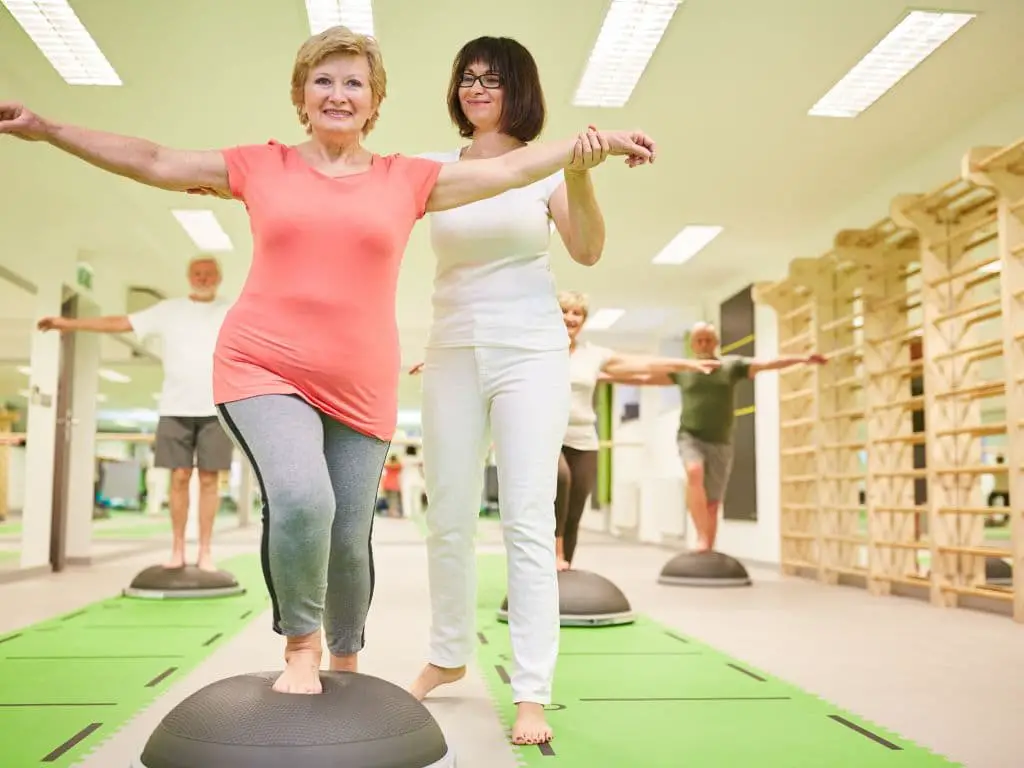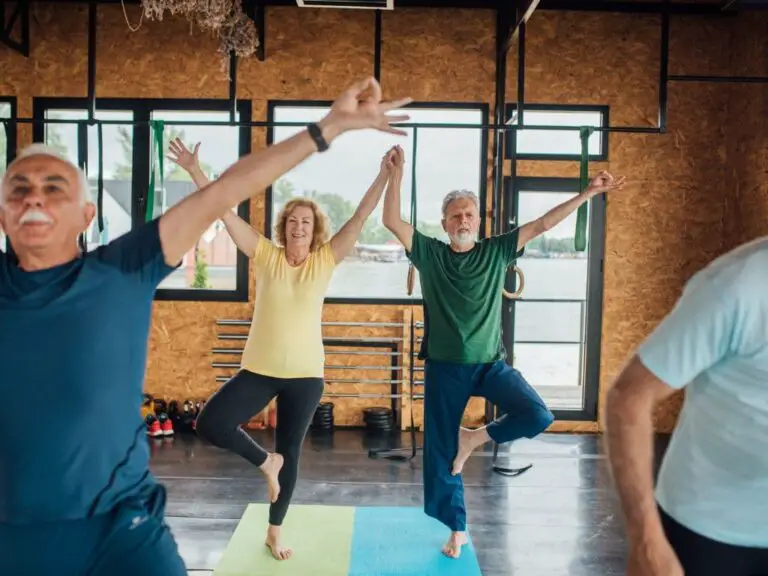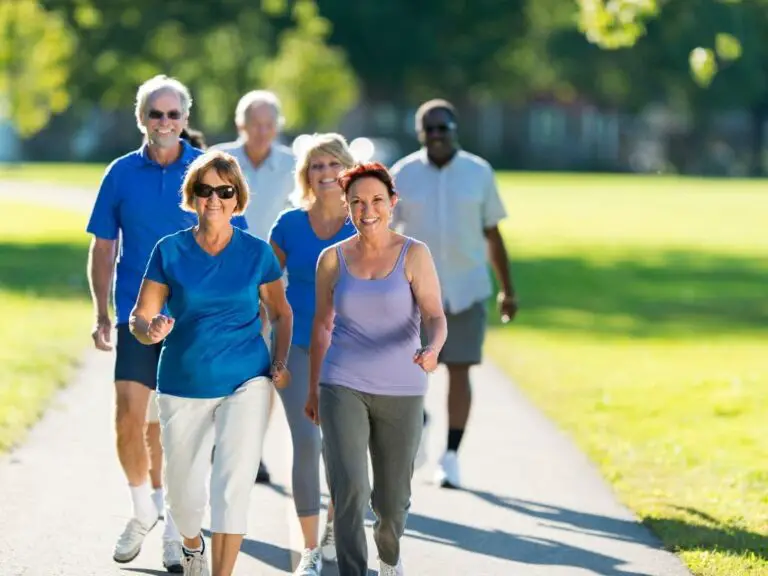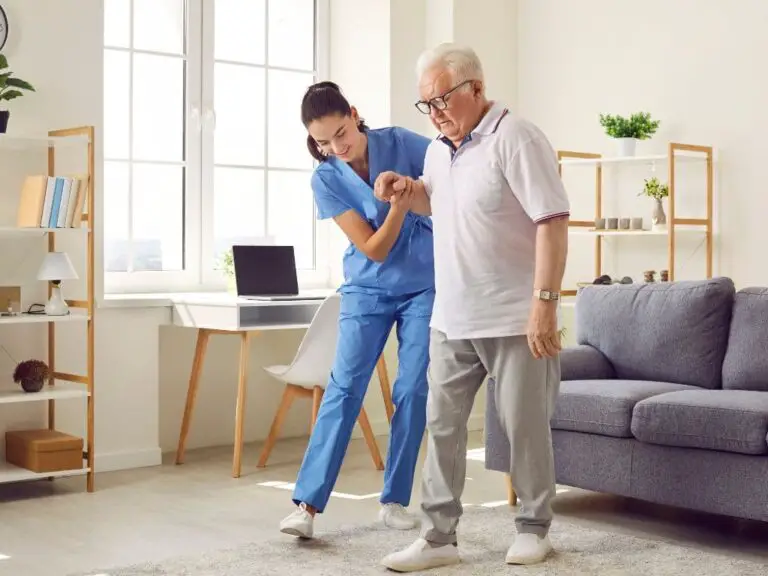What Causes Loss of Balance in Seniors?
The ability to maintain equilibrium and posture is something that many take for granted. However, as we age, the coordinated movements of the eyes, inner ear, and muscles required to keep balance often begin to falter. Loss of balance is a common problem among senior adults that can have profound effects on their health, mobility, and quality of life.
Loss of balance in seniors is primarily caused by age-related changes such as deterioration of the nervous system and inner ear structures, decreased muscle mass and strength, arthritis, and vision problems. Other factors include medical conditions like Parkinson’s disease, Multiple Sclerosis, and dementia. Certain medications and injuries can also lead to balance issues.
Understanding the causes, symptoms, diagnosis and treatment of balance issues can help seniors and their loved ones address this concern.

What Is the Importance of Balance in Seniors?
The ability to maintain balance and stability is extremely important for seniors. Loss of balance can have wide-ranging negative effects on a senior’s life.
First and foremost, balance is critical for mobility and preventing falls. As we age, decreased muscle strength, neurological issues and deteriorating inner ear function make it more difficult to quickly adjust our posture when unsteady. Without adequate balance, seniors are at high risk for slips, trips and falls. Falling is the top cause of injuries and even death for those over 65. Fractured hips, head trauma, lacerations and other severe injuries can result from falls. Avoiding falls is crucial for independent living, as injurious falls often lead to extended hospital stays, rehabilitation treatment, and loss of confidence in walking and daily activities. Strong balance allows seniors to move about securely and reduces chances of sustaining dangerous fall-related injuries.
Balance is also essential for seniors to perform routine activities independently and have a high quality of life. Simple tasks like getting dressed, bathing, cooking, cleaning and leisure activities all require a basic level of stability and coordination. Poor balance interferes with a senior’s ability to care for themselves, live actively and feel autonomous. Loss of balance often causes seniors to isolate themselves due to fear of falling or embarrassment over unsteadiness. This social withdrawal leads to further physical decline and depression. Seeking treatment for balance issues and using mobility aids enables seniors to maintain valued daily routines and social connections.
Balance also helps seniors exercise regularly and stay physically fit. Weight-bearing exercise improves bone density, muscle strength, heart health and mental acuity. However, seniors with equilibrium problems struggle with even basic movements like walking or climbing stairs. They tire easily, further worsening instability. With poor balance, seniors often stop exercising and become sedentary. This deconditioning leads to faster loss of mobility. Maintaining balance through targeted exercise and therapy supports overall fitness for seniors.
Balance impacts every aspect of health and lifestyle for seniors. Stability allows confident mobility, independent functioning, regular exercise, and avoidance of dangerous falls. Diagnosing and treating balance disorders improves lifespan, safety and quality of life for aging adults.
Why Is Maintaining Equilibrium Crucial for Seniors?
The ability to balance is essential for seniors to move around and function independently. Postural instability and poor balance put seniors at high risk for falls and injuries. Falls are the leading cause of both fatal and nonfatal injuries among those 65 and older, so maintaining stability is extremely important. Without adequate balance, seniors lose confidence and mobility, which can lead to further physical decline and loss of independence. Strong balance helps seniors stay active and reduces chances of dangerous falls.
How Does Age Affect the Ability to Maintain Posture and Move Around?
Aging causes various changes that can impair balance. As we get older, the nervous system and inner ear structures involved in balance can deteriorate. Seniors also experience decreased muscle mass and strength, arthritis, and poorer vision and sensation in the feet. These age-related changes make it harder to coordinate movements and quickly correct posture when unsteady. Impaired mobility from conditions like Parkinson’s disease also affects balance. The natural process of aging means seniors have to work harder to maintain stability.
What Are the Common Causes of Loss of Balance in Seniors?
There are many potential causes that can lead to balance issues in seniors. The most prevalent causes involve age-related medical conditions, medications, injuries, and natural decline in stability that occurs with advancing age.
As we grow older, common medical conditions like Parkinson’s disease, arthritis, diabetes, cardiovascular disease and neurological disorders often develop. These diseases directly affect mobility, joint health, vision, circulation and coordination – all factors critical for balance. Parkinson’s causes slowed movements, rigidity and impaired coordination that negatively impact stability. Arthritis in the neck, back, hips and knees contributes to pain and joint stiffness that make balancing difficult. Diabetes can cause vision changes and peripheral neuropathy that causes tingling and numbness in the feet, disrupting balance signals. Strokes and other cardiovascular disease impair blood flow to the brain which controls balance. Multiple sclerosis, dementia and other neurological diseases also progressively damage parts of the nervous system involved in maintaining equilibrium. Managing these chronic age-related diseases through proper treatment, diet, exercise and medication adherence helps delay related balance issues.
Many prescription and over-the-counter medications seniors take also list dizziness or lightheadedness as potential side effects. Medications like blood pressure pills, diuretics, antidepressants, and sedatives affect circulation, fluid levels and neurochemicals that influence balance control. Reviewing drug combinations and dosages with doctors can identify medicines that contribute to instability. Adjusting regimens may improve balance disorders with a medication link.
Injuries from falls or accidents are another source of balance dysfunction in seniors. Concussions, inner ear damage, hip fractures, spine injuries, torn ligaments and other trauma affect mobility and joint function. Getting assessed by rehabilitation specialists helps determine if residual issues related to injuries are impairing balance. Targeted therapy strengthens areas affected by injury to maximize stability.
The natural aging process itself diminishes balance over time. Age-related changes like declining vision, reduced sensation in the feet, decreased muscle mass, and degeneration in parts of the brain and inner ear all gradually impair the complex coordination needed to balance properly. Ongoing exercise and balance training helps seniors compensate for these age-related deficits. But ultimately, some loss of stability occurs naturally with advanced age.
How Do Medical Conditions Like Parkinson’s Disease, Multiple Sclerosis, and Dementia Affect Balance in Seniors?
Many common age-related medical conditions can negatively impact balance. Neurodegenerative diseases like Parkinson’s, multiple sclerosis, and dementia affect coordination and mobility, resulting in balance issues. Arthritis in the neck, back, knees or feet also disturbs balance. Diabetes can cause nerve damage and vision problems leading to instability. Cardiovascular conditionslike stroke and heart disease impair blood flow, which disrupts brain signals and inner ear function involved in balance.
How Can Medications Contribute to Loss of Balance in Seniors?
Certain prescription and over-the-counter medications have side effects that interfere with balance. Drugs like blood pressure medications, diuretics, antidepressants, and sedatives can sometimes cause lightheadedness or dizziness. Some medications also impair coordination, reaction time or vision, making seniors more prone to unsteadiness and falls. Reviewing drug regimens with doctors can identify medicines that may be negatively affecting balance.
How Do Injuries Lead to Loss of Balance in Seniors?
Injuries involving the brain, inner ear or bones and joints often disturb balance. Head trauma, concussions or ear damage from infection can impair equilibrium. Injuries from falls that affect mobility of the back, pelvis, legs and feet also contribute to stability issues. Getting assessed after an injury is key, as treating the source of the problem can help restore proper balance and prevent future falls.
What Are the Symptoms of Loss of Balance in Seniors?
There are several key symptoms that can indicate a senior is experiencing challenges with balance. Two of the most common early warning signs are dizziness and vertigo.
Dizziness makes seniors feel lightheaded, woozy or unsteady. They may feel that they are bobbing and weaving when trying to walk in a straight line. The room may seem like it is spinning around them, especially when getting up suddenly from a seated position. Dizziness results when the systems controlling spatial orientation and equilibrium are not working properly. When seniors feel recurring or severe spells of dizziness, it signals there is a problem with their balance system. Dizziness increases their risk of falls and injury. Seeking medical treatment for persistent dizziness can diagnose underlying balance disorders before a dangerous fall occurs.
Vertigo is another disturbing symptom where seniors feel that they are moving when they are actually standing or sitting still. Vertigo causes a spinning, swaying sensation, sometimes accompanied by nausea. It makes it difficult for seniors to stand upright without veering or tilting. One common cause of vertigo in seniors is benign paroxysmal positional vertigo or BPPV. This condition is due to loose calcium crystals in the inner ear canals that trigger false sensations of motion. Getting evaluated for vertigo can identify treatable causes like BPPV. With treatment, the debilitating spinning feelings can be relieved.
Other signs of potential balance problems include needing to frequently steady oneself on furniture when walking, relying heavily on a walker or cane, difficulty turning or changing directions while walking, and generally feeling unsteady on one’s feet. Seniors may also report recurring instances of almost falling when transitioning positions, like getting up from a chair. These are often early indicators that the systems controlling balance and stability are starting to falter. Addressing subtle symptoms early on leads to the best functional outcomes for seniors experiencing balance issues. With proper diagnosis and treatment, balance disorders can often be well-managed to help seniors live actively and independently.
How Is Dizziness Related to Loss of Balance?
Dizziness is a common early warning sign of balance issues. Seniors may feel lightheaded, woozy or unsteady, and have a sensation that the room is spinning. Dizziness indicates the systems controlling balance and spatial orientation are not working properly. Severe or recurring dizziness should be evaluated, since it can lead to instability, increase fall risk, and signal serious medical problems.
What Role Does Vertigo Play in Loss of Balance?
Vertigo, or the feeling that one is moving when standing still, results from inner ear problems and is a major cause of balance problems. Vertigo causes a spinning sensation and can make seniors veer sideways or be unable to stand upright. Benign paroxysmal positional vertigo (BPPV), an inner ear condition where ear crystals become dislodged, frequently causes vertigo in seniors. Seeking treatment for vertigo can often resolve balance issues.
How Is Loss of Balance Diagnosed in Seniors?
Diagnosing the underlying cause of balance issues in seniors involves a comprehensive evaluation by a medical professional, usually a primary care doctor, neurologist or audiologist. They will conduct a series of exams, review the senior’s symptoms and medical history, and often order specialized tests to pinpoint the problem.
The physician will first perform basic tests of balance, stability and mobility. These include asking the senior to stand on one foot, monitoring their gait as they walk, observing their ability to stand upright with their feet together and eyes closed, and assessing their postural sway. Blood pressure readings while lying down and then quickly standing check for orthostatic hypotension, a form of low blood pressure that can cause dizziness. Muscle strength, range of motion, coordination, and reflexes are evaluated for deficits.
The doctor also reviews all current prescription medications, looking for those that may cause side effects like dizziness. Vision and inner ear function are examined. Medical conditions like heart disease, neurological diseases, diabetes, and arthritis are evaluated through laboratory tests.
Advanced diagnostics can include videonystagmography to document abnormal eye movements, rotational chair tests to examine inner ear disorder responses, CT and MRI brain scans to assess cardiovascular and central nervous system disorders, and electromyography to measure muscle and nerve responses.
By compiling findings from the medical history, physical examination, lab work, and specialized tests, physicians determine the underlying disorder contributing to a senior’s balance problems. Common diagnoses include benign paroxysmal positional vertigo (BPPV), Ménière’s disease, Parkinson’s disease, stroke, neuropathy, heart conditions, and brain injury. Identifying the root cause then guides the appropriate treatments to help resolve or manage the senior’s instability.
What Tests Are Used to Diagnose Loss of Balance?
Doctors use a variety of exams and tests to evaluate balance and pinpoint causes. They assess sensory function, muscle strength, range of motion, heart health, and medications. Postural stability tests check if seniors can stand upright with eyes closed or feet together. Additional tests like videonystagmography, rotational chair tests, and CT or MRI scans help identify inner ear, neurological or brain-related causes.
How Can Doctors Determine the Cause of a Senior’s Loss of Balance?
Diagnosing balance disorders involves reviewing the senior’s symptoms, medical history and test results. Balance problems plus hearing loss and ringing ears point to inner ear disorders like Ménière’s disease. Stroke risk factors like high blood pressure combined with acute dizziness suggest cardiovascular causes. Slowed movements and tremors indicate Parkinson’s disease. Known neurological condition along with worsening stability points to that disease’s progression. Identifying the trigger is key for proper treatment.
How Is Loss of Balance Treated in Seniors?
Treating balance issues in seniors focuses on addressing the underlying condition causing the instability. The specific treatments utilized will depend on the diagnosis.
For inner ear disorders like BPPV or Ménière’s disease, common treatments include head maneuvers done by clinicians to reposition loose inner ear crystals causing vertigo, changes to diet and fluid intake to control symptoms, medication to reduce dizziness and nausea, and sometimes surgery for Ménière’s patients who do not improve with other treatments. Physical therapy is also used to help compensate for inner ear dysfunction.
If medication side effects are causing dizziness or unsteadiness, doctors may adjust dosages, change timing of administration, or prescribe alternative medications that do not affect balance. Making the smallest effective dose changes can improve stability while still managing the original medical condition.
For neurological diseases like Parkinson’s disease and multiple sclerosis that involve progressive loss of coordination and mobility control, medications can minimize tremor and improve muscle function. Patients also utilize mobility aids like walkers and canes to optimize safety and prevent falls. Physical therapy maintains flexibility, strength and balance skills.
Arthritis treatment focuses on pain management, mobility aids, and gentle exercises to retain range of motion in affected joints. Diabetes management aims for optimal blood sugar control to prevent or minimize neuropathy. Assistive devices and therapy aid those with orthopedic injuries or neurological trauma.
While not curative, some medications can provide temporary relief for symptoms like vertigo and dizziness as doctors treat the underlying disorder. However, the risks of side effects often limit medication use for balance issues in seniors. Non-pharmacological approaches tend to be better tolerated and more effective. Maintaining treatment for diagnosed conditions and proactively managing contributing factors like vision loss enables seniors the best chance of maximizing their balance and mobility.
What Treatments Are Available for Conditions That Cause Loss of Balance, such as BPPV and Ménière’s Disease?
Treating balance disorders starts with addressing diagnosed underlying conditions. Ménière’s disease is treated with diet changes, medications, and surgery for serious cases. BPPV is treated effectively with canalith repositioning maneuvers by clinicians that relocate loose ear crystals. If medications cause dizziness, adjusting dosages or prescribing alternatives can help. Physical therapy also improves strength and mobility issues affecting stability.
Are There Medications That Can Help With Symptoms Like Dizziness and Vertigo?
While not curative, some medications can provide symptom relief. Motion sickness and anti-nausea medications help reduce dizziness and vertigo. Vestibular suppressants like Valium lessen inner ear disturbances. Diuretics alleviate fluid buildup contributing to Ménière’s disease. Medication effects should be monitored closely, as side effects like drowsiness increase fall risks. Non-drug approaches are ideal if possible.
How Can Seniors Prevent Loss of Balance?
While some loss of balance is inevitable with age, there are many ways seniors can try to preserve and optimize their stability through lifestyle measures and proactive care.
Staying physically active with regular cardiovascular, strength training, and balance exercises helps maintain mobility and coordination. Activities like tai chi, yoga, and qigong incorporate gentle movements that improve posture, core strength, and mind-body awareness. Walking, dancing, and low-impact aerobics keep the legs, feet and ankles flexible and build supporting muscles. Stretching maintains joint suppleness. Balance exercises like tandem stands, heel-toe walking, and using a wobble board directly challenge equilibrium in safe ways.
Eating a nutritious diet with adequate calcium and vitamin D promotes bone, muscle and nerve health that enable balance. Managing medical conditions optimally, through adherence to treatment plans and medication regimens prescribed by doctors, helps delay associated mobility deficits. quitting smoking improves circulation. Having vision and hearing checked yearly and using prescribed glasses and hearing aids optimizes sensory inputs needed for equilibrium.
Making the home environment safer can prevent falls that undermine balance. This includes installing grab bars in bathrooms, using non-slip mats in showers, removing trip hazards like rugs and clutter, and improving lighting. Maintaining mobility through assistive devices like canes and walkers enables seniors to move safely when stability begins to decline. Being proactive helps maximize balance and functioning. However, it’s also important for seniors to consult a doctor promptly about sudden dizziness or unsteadiness to address new medical issues threatening their equilibrium.
What Lifestyle Changes Can Help Improve or Maintain Good Balance?
Staying active with regular exercise tailored for balance and posture is key. Low-impact exercises like tai chi, yoga, and qigong improve core strength. Aerobics, walking, and dancing assist coordination. Stretching keeps joints limber. Adequate calcium and vitamin D intake promotes bone and muscle health. Managing chronic illnesses optimally also supports stability. Assistive devices provide additional support when mobility is impaired.
Are There Exercises That Can Improve a Senior’s Sense of Balance?
Specific exercises that strengthen legs, ankles and core muscles help seniors stay balanced. Standing on one foot, walking heel to toe, and using a balance board stresses stability in safe ways. Yoga tree pose and tai chi single leg stands also boost equilibrium. Balance exercises are most effective when done regularly. Seniors should have a sturdy chair or bar nearby for support when trying new exercises. Professional trainers can demonstrate proper techniques.
What Are the Risks Associated With Falling for Seniors With a Loss of Balance?
Falls are the top cause of fractures, trauma, disability and injury-related mortality in those over 65. Seniors are at high risk for serious injury due to diminished bone density and fragility from osteoporosis. Brain bleeding, hip fractures, head trauma, and major lacerations are common fall-related injuries. Hospital and rehabilitation stays due to falls lead to long recovery times. Falling also leads many seniors to fear leaving home and lose social connections.
How Can Falls Be Prevented Among Seniors Experiencing Loss of Balance?
Since poor balance markedly increases falling, addressing stability issues is the best fall prevention. Medical treatment, physical therapy, assistive devices and gait training help maximize mobility and safety. Eliminating home hazards like loose rugs and clutter is crucial. Proper footwear, lighting and handrails also reduce risk. Seniors with severe instability may benefit from a care facility with greater supervision and assistance.
How Can Seniors Stay Safe and Active if They Have Loss of Balance?
Seniors with balance problems need to exercise judicious caution in their activities. Walkers or canes should be used for support outside the home. Spaces for exercising should be clear of objects and have chairs or bars to grasp if unsteady. Shower chairs, grab bars, and handrails enable safer bathing and transfers. Routes for walking should be flat, well-lit and non-slippery. Standing slowly and allowing time for dizziness to resolve prevents rushing and falling. Assistance may be needed for uneven terrain.
How Can Social Connections Be Maintained When Leaving Home Is Difficult?
For homebound seniors, contact can be maintained through regular phone calls, video chats and visits from family and friends. Virtual exercise classes and religious services allow participation without leaving home. Support groups connect seniors facing similar mobility challenges. Transportation assistance from charities and social services enables doctor appointments and errands. These resources prevent isolation and support meaningful engagement. With some adaptations, most seniors can enrich their lives despite stability limitations.
Conclusion
Balance disorders arise from many age-related causes and increase seniors’ fall risks. Addressing underlying medical conditions, making home modifications, using mobility aids, and exercising for strength and balance can help compensate for stability issues. With appropriate support and precautions, seniors can safely maintain activity and independence despite balance declines. Seeking medical advice at the first sign of dizziness or equilibrium problems leads to the most successful outcomes. Staying balanced and steady is key for seniors’ health, mobility and safety.
Frequently Asked Questions
-
What causes loss of balance with age?
Loss of balance in seniors can be caused by various factors, including age-related changes in the nervous system and inner ear structures, decreased muscle mass and strength, arthritis, poor vision and sensation in the feet, as well as medical conditions like Parkinson’s disease, multiple sclerosis, dementia, and diabetes. Medications with side effects that affect balance and injuries to the brain or bones can also contribute to instability.
-
What is the first step in a balance training progression?
Balance training is essential for the rehabilitation of people with disabilities. It starts from sitting to seated, then moves to standing or walking. It is recommended to move from easier tasks to harder ones.
-
Do you wear shoes for BODYBALANCE?
What equipment do you need for a BODYBALANCE workout? BODYBALANCE doesn’t require any special equipment, however you may want to bring a yoga mat. Because it’s soft, sturdy and supportive, the MBX MAT makes it easy to do all of these poses. Also, you don’t require any footwear.
-
Why is balance so important in a good composition?
One of the most essential elements in a composition is balance. A balance is an opposing element that results in harmony and equilibrity. For the observer, equilibrium is intuitively a comfortable state. Our visual perception corresponds with this symmetry vertically in the human body.
-
What muscles are most important for balance?
You can improve stability by strengthening your lower body. Our largest muscles are located in our lower bodies. Balance is also possible thanks to the importance of your adductors, which are inner thighs muscles.
-
What is the difference between Pilates and BODYBALANCE?
Yoga might be the best option for you if you’re looking for an emotional and mental process that also has a physical component. The Body Balance, which combines Yoga moves and Pilates moves with meditation at the conclusion, is more common at your local gym.
-
Does low B12 cause balance problems?
A B12 deficiency can cause ataxia (impaired balance and coordination) which is a neurological condition. B12 deficiencies can lead to difficulty in walking or balancing.
-
What vitamin Are you lacking if you get dizzy?
Vitamin B12 deficiencies are easy to diagnose and treat. However, they can often be overlooked as a cause for dizziness. If you are experiencing dizziness, ask your doctor to perform a quick blood test. Vitamin B12 is found in meats, milk products and fortified cereals.
-
Are balance boards good for you?
A balance board is a great training tool for protecting yourself from falls and preventing injuries in sports. A balance board can also be used to improve balance and coordination. Stronger lower legs muscles, particularly the peroneals.
-
How does eye direction achieve balance?
All edges, shapes and/or groups may indicate a visual direction. You can use this to balance the heavier side of an object by having your eyes point towards the lighter side. This transfers visual significance. Strong directional effects can be achieved by a linear object, shadow edges, or even the edge of a lamp.






